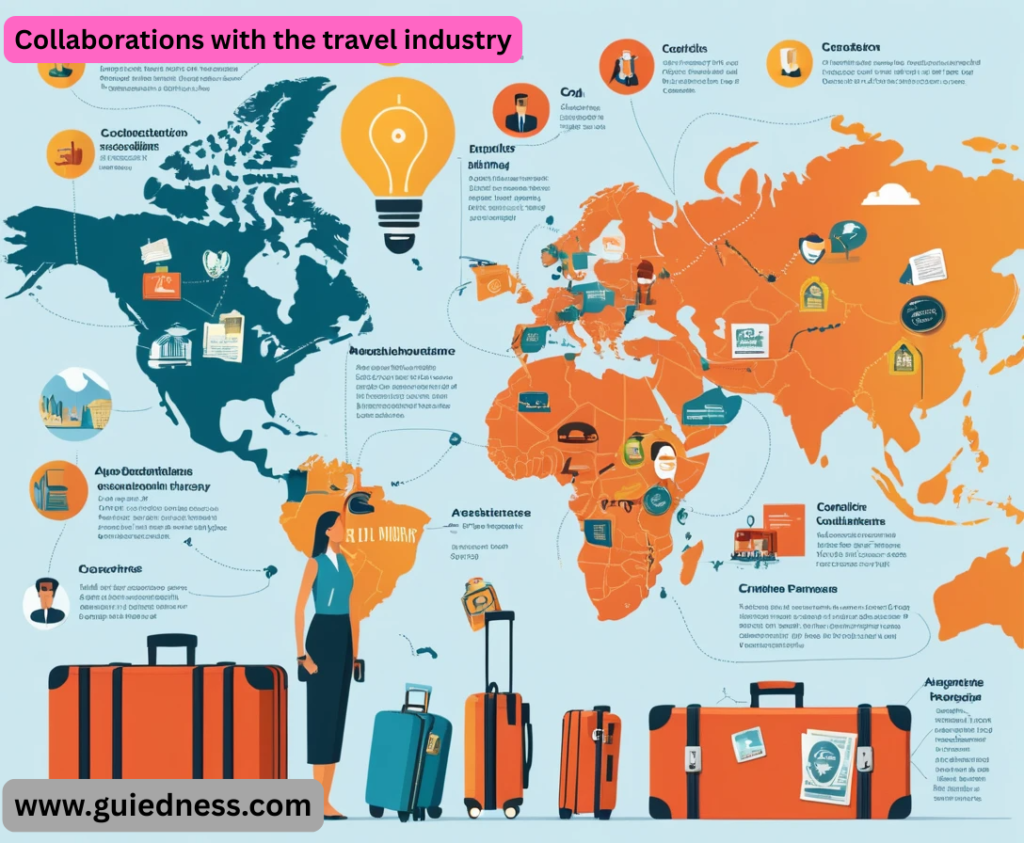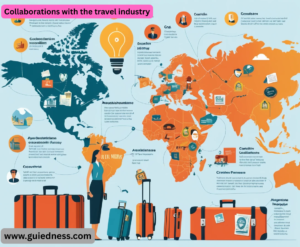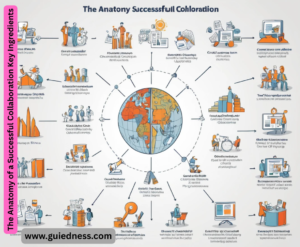Collaborations with the travel industry Of course. Collaborations with the travel industry are a fundamental growth strategy for brands, destinations, and tech companies alike. They leverage shared audiences to create value that no single entity could achieve alone. Here’s a comprehensive breakdown of travel industry collaborations, including the types, key players, benefits, and real-world examples.
Types of Collaborations & Partnerships
- Collaborations can range from simple cross-promotions to deep, integrated business partnerships.
Brand & Destination Marketing Partnerships
- Objective: To associate a brand with a desirable lifestyle or location.
- How it works: A non-travel brand (e.g., fashion, automotive, film) partners with a tourism board, airline, or hotel chain to create exclusive content, packages, or experiences.
- Example: Airbnb x Barbie. To promote the Barbie movie, Airbnb listed a real-life Malibu DreamHouse on their platform. This generated massive global PR, linked the Airbnb brand to a pop-culture phenomenon, and positioned travel as a form of living your dreams.
Co-Branded Loyalty Programs
- Objective: To increase customer retention and spending by offering more valuable rewards.
- How it works: An airline or hotel chain partners with a credit card company, bank, or retail brand to allow points/miles to be earned and redeemed across both ecosystems.
- Example: Marriott Bonvoy x American Express. The Marriott Bonvoy Brilliant American Express Card allows users to earn points on everyday spending that can be redeemed for hotel stays, flights, and experiences, benefiting both companies’ loyalty metrics.
Online Travel Agency (OTA) & Supplier Integrations
- Objective: To expand inventory and reach for suppliers while providing choice and convenience for OTAs.
- How it works: Hotels, airlines, car rental companies, and tour operators list their inventory on OTA platforms like Booking.com, Expedia, and Tripadvisor.
- Example: A small boutique hotel gains access to a global audience it couldn’t afford to market to by listing on Booking.com. In return, Booking.com takes a commission, enriching its own inventory.
Influencer & Creator Campaigns
- Objective: To generate authentic content and reach new, trusted audiences.
- How it works: A tourism board or travel company sponsors influencers or content creators to experience their product and share it with their followers.
- Example: Tourism Australia x influencers. They frequently invite travel creators from key markets (e.g., USA, UK, China) on curated trips, resulting in beautiful Instagram posts, YouTube vlogs, and blog articles that serve as powerful social proof.
Technology & Distribution Partnerships
- Objective: To improve operational efficiency, customer experience, and distribution reach.
- How it works: Travel companies integrate with tech providers for critical services.
- GDS (Global Distribution System): Amadeus, Sabre, and Travelport connect airlines and hotels to travel agents worldwide.
CRM and Marketing Automation Salesforce HubSpot
- Metasearch Engines: Google Hotels, Kayak, Skyscanner (airlines and hotels pay for clicks and bookings).
- Experience Platforms: Viator, GetYourGuide (for tours and activities).
Sustainable & Community-Based Tourism Partnerships
- Objective: To promote responsible travel and ensure tourism benefits local communities.
- How it works: Tour operators or hotels partner with local NGOs, conservation projects, or community cooperatives.
- Example: Intrepid Travel partners with local NGOs and community leaders to develop tours that have a positive social impact, such as their community-based tourism projects in Cambodia and Jordan.
Key Players in Travel Collaborations
- Accommodation: Hotel chains, boutique hotels, hostels, vacation rental platforms (Airbnb, Vrbo).
- Transportation: Airlines, cruise lines, car rental companies, rail networks.
- Destinations: National Tourism Boards (e.g., Visit Britain, Incredible India), Regional/Destination Marketing Organizations (DMOs).
- Distribution & Booking: Online Travel Agencies (OTAs) like Booking Holdings, Expedia Group, metasearch engines, and traditional travel agents.
- Experiences: Tour operators, activity providers, event ticketing companies.
- Technology: GDS, CRM software, booking engines, AI and data analytics firms.
- Ancillary Services: Travel insurance companies, credit card issuers, travel gear brands.
Benefits of Collaboration
- Expanded Reach & New Audiences: Tap into the partner’s established customer base.
- Enhanced Value Proposition: Combined offerings (e.g., flight + hotel + car) are more attractive than standalone products.
- Shared Resources & Costs: Co-marketing campaigns split the bill and increase impact.
- Increased Revenue: Cross-selling and upselling opportunities directly boost the bottom line.
- Improved Customer Loyalty: Integrated loyalty programs make customers less likely to switch to competitors.
- Innovation: Tech partnerships can provide access to cutting-edge tools (AI, data analytics) without building them in-house.
- Brand Enhancement: Aligning with a respected or trendy partner can boost brand perception.
Real-World Examples
- Delta Air Lines x Lyft: This partnership allows SkyMiles members to earn miles on Lyft rides and offers Lyft riders perks like priority pickup at airports. It seamlessly connects two parts of the travel journey (air and ground transport).
- GoPro x Various Tourism Boards: GoPro partners with destinations like Hawaii or Costa Rica. The destination provides epic backdrops, and GoPro provides the cameras, resulting in stunning user-generated content that markets both the action camera and the destination.
- Disney x Adventures by Disney: Disney leverages its powerful brand to operate high-end, guided group tours to global destinations like Egypt, Italy, and Alaska. This is a collaboration between Disney’s storytelling expertise and the local tourism suppliers in each country.
- Booking.com’s Booking Booster: This is a collaboration for good. Booking.com provides a grant and mentorship program for sustainable tourism nonprofits, strengthening its commitment to the community and building positive brand equity.
Challenges & Considerations
- Brand Alignment: The partnership must make sense to the consumer. A mismatch can confuse audiences or damage brand reputation.
- Complexity: Integrating technology, loyalty programs, and billing systems can be technically and legally challenging.
- Equity: Ensuring both parties benefit fairly from the partnership is crucial for its long-term success.
- Data Sharing & Privacy: Collaborations often require sharing customer data, which must be handled in compliance with regulations like GDPR.
The Anatomy of a Successful Collaboration Key Ingredients
- Not all partnerships are created equal. The most successful ones share several common traits:
- Shared Values & Target Audience: The most crucial element. A luxury wellness resort partnering with a high-end athleisure brand (e.g., Lululemon or Sweaty Betty) makes sense because their customers value similar things: health, self-care, and premium quality. A budget hostel partnering with that same brand would not.
- Collaborations with the travel industry Clear Objectives & KPIs: Both parties must agree on what success looks from the start. Is it:
- Brand Awareness? Measured by media impressions, social media mentions, reach.
- Lead Generation? Measured by new email sign-ups, brochure requests.
- Direct Sales? Measured by revenue, number of bookings, redemption rate of an offer.
- Content Creation? Measured by the volume and quality of assets produced.
- A Seamless Customer Experience: The collaboration should remove friction, not add it. The process of booking and redeeming a package or offer should be intuitive. If a customer has to make five phone calls to use a “special offer,” the collaboration has failed.
- A Mutually Beneficial Value Exchange: Each party must bring something of value to the table and feel they are getting a fair return. This could be:
- Access: to an audience, to a destination, to technology.
- Content: high-quality photos, videos, testimonials.
- Revenue: direct sales, commission, grant money.
- Data: insights into customer preferences and behaviors.
- A Strong Co-Marketing Plan: The partnership can’t just exist on a contract; it needs to be brought to life. How will both parties promote it? Through which channels (email, social media, PR, in-store)? Who is responsible for what?
Emerging Trends in Travel Collaborations
The landscape is constantly evolving. Here’s what’s new and next:
- Phygital Experiences & The Metaverse: Destinations are creating digital twins to allow potential visitors to “try before they fly.”
- Example: Visit Dubai launched a virtual metaverse platform, “Dubirama,” offering immersive previews of attractions. This could easily evolve into a collaboration with VR headset manufacturers or gaming platforms.
- AI-Powered Personalization Partnerships: Travel companies are partnering with AI firms to hyper-personalize the customer journey.
- Example: A hotel chain could partner with an AI like ChatGPT or Claude to power a conversational, intelligent trip-planning assistant directly on their website.
- “Super-App” Ecosystems: Companies are moving beyond single partnerships to create entire ecosystems where the customer never has to leave their platform.
- Example: Booking.com now offers flights, rental cars, airport taxis, and restaurant reservations alongside hotels, effectively partnering with or acquiring providers in all these verticals to become a one-stop travel shop.
- Collaborations with the travel industry Carbon Removal & Sustainability Partnerships: Beyond “do no harm,” companies are actively partnering to become climate-positive.
- Example: Skyscanner partners with climate tech companies like Selectra to provide travelers with transparent options to calculate and offset the carbon footprint of their flights.
- Content-to-Commerce Collaborations: Media companies are becoming direct booking platforms.
- Example: Condé Nast Traveler (a media brand) has a partnership with Mr & Mrs Smith (a boutique hotel booking platform). Readers can discover a hotel in an article and book it instantly without leaving the page, creating a seamless path from inspiration to purchase.
How to Forge a Successful Partnership: A Practical Approach
- Internal Audit: Start by looking inward. What are your goals? What are your strengths (a loyal audience, a unique destination, great tech)? What are your weaknesses (low brand awareness, limited reach, outdated tech)? This will show you what you need from a partner.
- Ideal Partner Profile: Based on your audit, sketch out the profile of your ideal partner. What industry are they in? What size are they? What values must they have? Who is their audience?
- Identify & Research: Brainstorm a list of companies that fit this profile. Research them thoroughly. How have they partnered with others in the past? What does their marketing look like? Is there any news about their strategic goals where a partnership might fit?
- Craft a Value Proposition: Before you reach out, prepare a concise “pitch.” Clearly articulate:
Who you are.
- Why a partnership makes sense (the shared audience/values).
- The specific idea for the collaboration.
- What’s in it for them (the value exchange).
- Find the Right Contact: Avoid the generic “info@” email. Use LinkedIn to find someone in Business Development, Strategic Partnerships, or Marketing. A personalized outreach to a specific person is infinitely more effective.
- Pilot and Scale: Propose starting with a small, limited-time pilot program. This is a low-risk way to test the concept, prove its value, and work out any kinks before committing to a large, long-term agreement.






